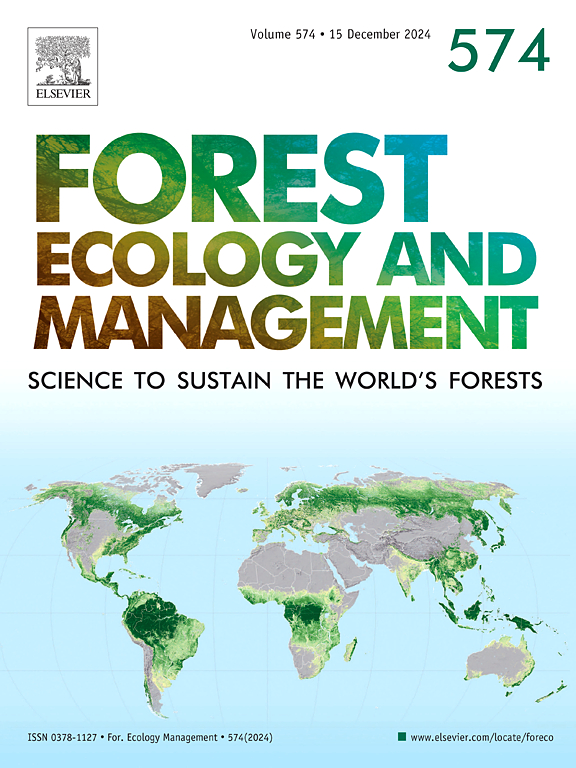Elevated tree mortality as a regeneration niche for oak? Testing different management approaches in a meliorated floodplain forest
IF 3.7
2区 农林科学
Q1 FORESTRY
引用次数: 0
Abstract
Pedunculate Oak (Quercus robur L.), a keystone species in European temperate floodplain forests, faces regeneration challenges due to dense canopies caused by altered hydrology and declined traditional land-use practices. Recently increasing canopy mortality due to climate change altered forest structures and may offer new opportunities for oak regeneration. Over two years, including a drought year, this study examined the effects of higher and lower canopy mortality in combination with and without thinning of flood-intolerant species in the understorey compared to larger silvicultural cuttings (up to 0.72 ha) on the vitality and growth of planted Q. robur saplings in a meliorated floodplain forest in Leipzig, Germany. Canopy mortality alone did not improve the oak regeneration due to dark understorey conditions mainly created by fast-growing, flood-intolerant maple. However, combining high canopy mortality with species-selective understorey thinning markedly enhanced oak sapling growth and vitality. This management approach created higher light availability compared to unmanaged sites, but oaks expressed lower drought stress, indicated by δ¹ ³C in leaves, compared to larger cuttings. While greater canopy openness generally improved oak performance, its benefits were weakened by drought stress which was primarily correlated positively to vapour pressure deficit. The results demonstrate the potential of small-scale, selective thinning to support Q. robur regeneration under changing environmental conditions. Continued monitoring is essential to assess long-term outcomes, especially as oaks require increasing light with age. This study underscores the need for adaptive management complementary to hydrological revitalisation measures in floodplain forests to sustain biodiversity and associated ecosystem functions.
提高树木死亡率作为橡树的再生生态位?在改良后的洪泛区森林试验不同的管理方法
有柄栎(Quercus robur L.)是欧洲温带洪泛平原森林的重要物种,由于水文变化和传统土地利用方式的减少,树冠密集,面临着更新的挑战。最近由于气候变化导致的树冠死亡率的增加改变了森林结构,并可能为橡树的再生提供新的机会。在两年多的时间里,包括干旱年,本研究考察了在德国莱比锡改良的洪漫平原森林中,与较大的造林扦插(高达0.72 ha)相比,在对林下抗洪物种进行间伐和不间伐的情况下,较高和较低的树冠死亡率对人工刺柏树苗的活力和生长的影响。树冠死亡本身并不能改善栎树的再生,这主要是由于快速生长、不耐洪水的枫树所造成的暗色林下条件。然而,高冠层死亡率与树种选择性林下疏伐相结合,显著提高了栎树幼树的生长和活力。与未管理的地点相比,这种管理方法创造了更高的光利用率,但与较大的插枝相比,橡树表现出较低的干旱胁迫,由叶片中的δ¹ ³C表明。虽然较大的冠层开度总体上提高了栎树的性能,但其效益受到干旱胁迫的削弱,干旱胁迫主要与蒸汽压赤字呈正相关。结果表明,在不断变化的环境条件下,小规模的选择性间伐有可能支持刺柏的再生。持续监测对于评估长期结果至关重要,特别是因为随着年龄的增长,橡树需要越来越多的光照。这项研究强调了在洪泛平原森林中需要适应性管理来补充水文振兴措施,以维持生物多样性和相关的生态系统功能。
本文章由计算机程序翻译,如有差异,请以英文原文为准。
求助全文
约1分钟内获得全文
求助全文
来源期刊

Forest Ecology and Management
农林科学-林学
CiteScore
7.50
自引率
10.80%
发文量
665
审稿时长
39 days
期刊介绍:
Forest Ecology and Management publishes scientific articles linking forest ecology with forest management, focusing on the application of biological, ecological and social knowledge to the management and conservation of plantations and natural forests. The scope of the journal includes all forest ecosystems of the world.
A peer-review process ensures the quality and international interest of the manuscripts accepted for publication. The journal encourages communication between scientists in disparate fields who share a common interest in ecology and forest management, bridging the gap between research workers and forest managers.
We encourage submission of papers that will have the strongest interest and value to the Journal''s international readership. Some key features of papers with strong interest include:
1. Clear connections between the ecology and management of forests;
2. Novel ideas or approaches to important challenges in forest ecology and management;
3. Studies that address a population of interest beyond the scale of single research sites, Three key points in the design of forest experiments, Forest Ecology and Management 255 (2008) 2022-2023);
4. Review Articles on timely, important topics. Authors are welcome to contact one of the editors to discuss the suitability of a potential review manuscript.
The Journal encourages proposals for special issues examining important areas of forest ecology and management. Potential guest editors should contact any of the Editors to begin discussions about topics, potential papers, and other details.
 求助内容:
求助内容: 应助结果提醒方式:
应助结果提醒方式:


